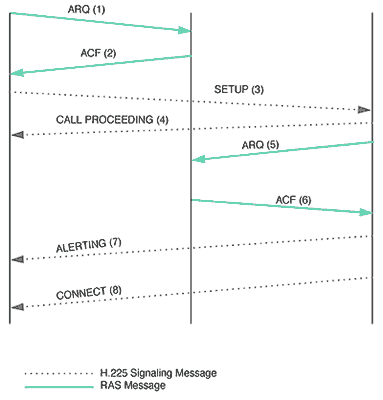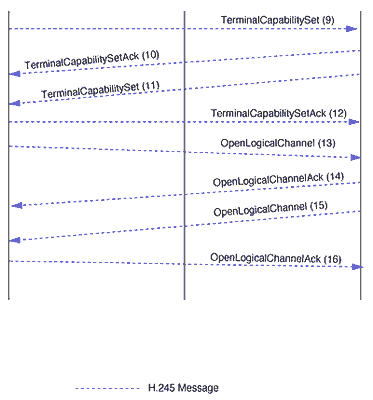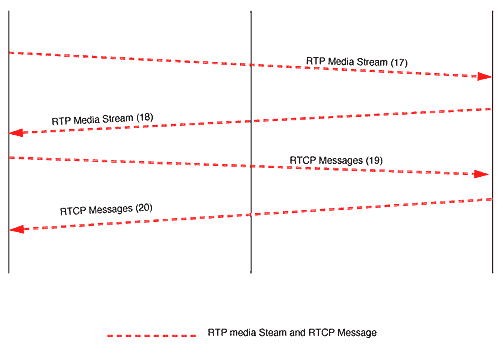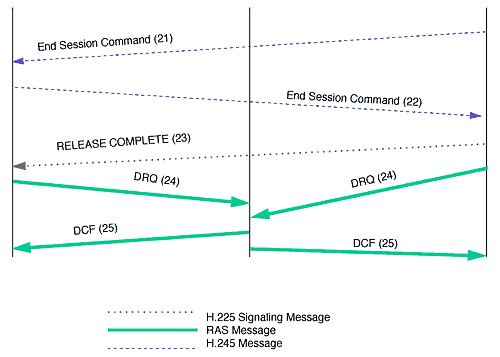creating an H.323 call
| establishing media communication
| releasing the call
| |
|---|
|
Assumptions in Figure 6 (H.323 call establishment)
|
two H.323 terminals (T1 and T2) connected to a gatekeeper.
| Direct call signaling
| the media stream uses RTP encapsulation
| |
|---|
|
Figure 6: H.323 Call Establishment
|

| 1. | T1 sends the RAS ARQ message on the RAS channel to the
gatekeeper for
registration. T1 requests the use of direct call signaling.
| 2.
| The gatekeeper confirms the admission of T1 by sending ACF to T1.
The
gatekeeper indicates in ACF that T1 can use direct call signaling.
| 3.
| T1 sends an H.225 call signaling "setup" message to
T2 requesting a
connection.
| 4.
| T2 responds with an H.225 "call proceeding" message to T1.
| 5.
| Now T2 has to register with the gatekeeper. It sends a
RAS ARQ message to the
gatekeeper on the RAS channel.
| 6.
| The gatekeeper confirms the registration by sending a
RAS ACF message to T2.
| 7.
| T2 alerts T1 of the connection establishment by sending an
H.225 "alerting"
message.
| 8.
| Then T2 confirms the connection establishment by sending an
H.225 "connect"
message to T1, and the call is established.
| |
|---|
|
Figure 7: H.323 Control Signaling Flows
|

| 9. | The H.245 control channel is established between T1 and T2.
T1 sends an
H.245 "TerminalCapabilitySet" message to T2 to exchange its capabilities.
| 10.
| T2 acknowledges T1's capabilities by sending an H.245
"TerminalCapabilitySetAck" message.
| 11.
| T2 exchanges its capabilities with T1 by sending an H.245
"TerminalCapabilitySet" message.
| 12.
| T1 acknowledges T2's capabilities by sending an H.245
"TerminalCapabilitySetAck" message.
| 13.
| T1 opens a media channel with T2 by sending an
H.245 "openLogicalChannel"
message. The transport address of the RTCP channel is included in the
message.
| 14.
| T2 acknowledges the establishment of the unidirectional
logical channel from
T1 to T2 by sending an H.245 "openLogicalChannelAck" message. Included in
the acknowledge message are the RTP transport address allocated by
T2 to be
used by the T1 for sending the RTP media stream and the RTCP address
received from T1 earlier.
| 15.
| Then, T2 opens a media channel with T1 by sending an H.245
"openLogicalChannel" message. The transport address of the RTCP channel is
included in the message.
| 16.
| T1 acknowledges the establishment of the unidirectional
logical channel from
T2 to T1 by sending an H.245 "openLogicalChannelAck" message.
Included in
the acknowledging message are the RTP transport address allocated by
T1 to be
used by the T2 for sending the RTP media stream and the RTCP address
received from T2 earlier. Now the bidirectional media stream
communication is
established.
| |
|---|
|
Figure 8: H.323 Media Stream and Media Control Flows
|

| 17. | T1 sends the RTP encapsulated media stream to T2.
| 18.
| T2 sends the RTP encapsulated media stream to T1.
| 19.
| T1 sends the RTCP messages to T2.
| 20.
| T2 sends the RTCP messages to T1.
| |
|---|
|
Figure 9: H.323 Call Release
|

| 21. | T2 initiates the call release. It sends an
H.245 "EndSessionCommand" message
to T1.
| 22.
| T1 releases the call endpoint and confirms the release
by sending an H.245
"EndSessionCommand" message to T2.
| 23.
| T2 completes the call release by sending an
H.225 "release complete" message
to T1.
| 24.
| T1 and T2 disengage with the gatekeeper by sending a
RAS DRQ message to
the gatekeeper.
| 25.
| The gatekeeper disengages T1 and T2 and confirms by sending
DCF messages
to T1 and T2.
| |
|---|